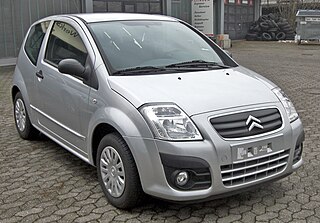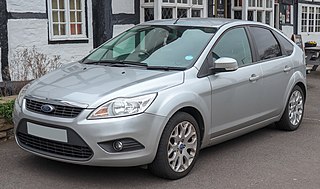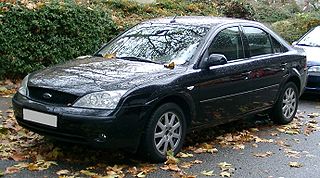
The Citroën C2 is a supermini that was produced by the French manufacturer Citroën, with production starting August 2003. It replaced the Citroën Saxo and was built at the Aulnay plant, on the outskirts of Paris. The Citroën C2 was discontinued in October 2009, and replaced by the Citroën DS3 in January 2010.

The Peugeot 307 is a small family car produced by the French automaker PSA Peugeot Citroën, under their Peugeot marque, from 2001 to 2008 in Europe, and was the successor to the Peugeot 306, which was discontinued in 2002 after being in production for nine years. Using the PSA PF2 platform, it was awarded the European Car of the Year title for 2002, and continued to be offered in China and certain South American markets through 2014, despite the September 2007 French launch of the 308, which is built on the same platform.

Mazda has a long history of building its own diesel engines, with the exception of a few units that were built under license.

The Citroën C6 is an executive car produced by the French car maker Citroën since 2005. The Citroën C6 was inspired by the Citroën C6 Lignage concept car with a fastback saloon like styling.

The Peugeot 607 is an executive car produced by the French manufacturer Peugeot from September 1999 to June 2010.

The Ford AJD engine was first developed as a V6 with a clean-sheet architecture and variable valve timing by Ford of Europe for its then subsidiaries Jaguar Cars and Land Rover, as well as for its partner PSA Peugeot Citroën working under the Gemini joint development and production agreement. It is called the AJD-V6 in the Jaguar and Land Rover vehicles and the DT17/DT20 by Citroën and Peugeot. The engines share the same bore/stroke ratio, with the V6 displacing 2.7 L (2,720 cc) and the V8 displacing 3.6 L (3,630 cc). The V6 was launched in 2004 and the V8 in 2006. The V6 engine meets the Euro IV emissions standards. A DT20 3.0 L (2,993 cc) was added in 2009 and is based on the DT17 2.7 L (2,720 cc). The V6 is used across many vehicles, from the Citroën C5 and C6, to the Land Rover Discovery, Range Rover, multiple cars in the Jaguar range, and also the Ford Territory and next gen Ford Ranger.
Multijet is Stellantis's term for its current common rail direct injection turbodiesel engine range. Most of the Fiat, Alfa Romeo, and Lancia range, as well as certain Chrysler, RAM Trucks, Jeep, and Maserati vehicles, are equipped with Multijet engines. Ownership of some Fiat Multijet designs is shared with General Motors as part of a settlement of the failed merger between the two auto conglomerates. The GM Powertrain Torino group in Turin, Italy, manages its interest in these engines. Some PSA Peugeot Citroën diesel engines are also rebadged JTD units, and vice versa. Fiat's common-rail diesel engine is also known as JTD, an initialism of Jet Turbo Diesel.

The PSA XUD is a diesel engine designed and built by PSA - Peugeot and Citroën. It is an Indirect injection (IDI) engine, that uses a version of the Ricardo Consulting Engineers Ricardo Comet V prechamber cylinder head design. The engine comes in 1.8 L (1,769 cc), 1.9 L (1,905 cc), and 2.1-liter displacements. The 2.1 has 12 valves, all displacements were built either naturally aspirated or turbocharged. The XUD was the predecessor to the HDI range of engines. Early HDi Engines were a PSA design, later 16-valve engines were jointly developed with Ford.
The PSA Group sells a variety of diesel automobile engines with the HDi designation. Earlier versions were exclusive to Peugeot and Citroën. In 1998, PSA entered into a joint venture with the Ford Motor Company to produce a range of new diesel engines. The joint venture makes identical engines which are fitted to a variety of vehicles from a range of car manufacturers. The engines are assembled in production plants in the cities of Trémery and Douvrin for PSA in France, at the Ford Dagenham plant in the UK, and Volvo Engine Plant in Skövde Sweden when Volvo was still under Ford ownership.

The PSA EW/DW engine is a family of straight-4 black-top automobile engines manufactured by the PSA Group for use in their Peugeot and Citroën automobiles. The EW/DW family was introduced in 1998 as a replacement for the XU engine. Some DW engines are produced as part of a joint-venture with Ford Motor Company.

The DLD is the name for an automobile engine family – a group of compact inline-four Diesel engines, involving development by Ford of Britain and/or PSA Group, and also Mazda where it is called the MZ-CD or CiTD. The Ford of Britain/PSA and joint-venture for the production of the DLD/DV was announced in September 1998. Half of the total engine count are produced at Ford of Britain's main plant at Dagenham, England and at Ford's Chennai plant in India, the other half at PSA's Trémery plant in France.

Prince is the codename for a family of straight-four 16-valve all-aluminium gasoline engines with variable valve lift and variable valve timing developed by BMW and PSA Peugeot Citroën. It is a compact engine family of 1.4–1.6 L in displacement and includes most modern features such as gasoline direct injection and turbocharger.

The Peugeot 408 is a compact car (C-segment) produced by Peugeot. It was unveiled on January 25, 2010, at the Beijing Auto Show and sales began in China on April 8, 2010. In November 2010, production of the 408 commenced in El Palomar, Buenos Aires, Argentina, with sales starting in April 2011.

The Peugeot 208 is a supermini car produced by the French automaker Peugeot. Unveiled at the Geneva Motor Show in March 2012 and positioned below the larger 308. The 208 replaced the 207 in 2012, and the car is currently at its second generation.

The Mazda L-series is a mid-sized inline 4-cylinder gasoline piston engine designed by Mazda as part of their MZR family, ranging in displacement from 1.8 to 2.5 liters. Introduced in 2001, it is the evolution of the cast-iron block F-engine. The L-series is used by Ford as their 1.8L to 2.5L Duratec world engine.

The international or global version of the Ford Ranger is a series of pickup trucks sold by Ford under the Ranger nameplate mainly for markets outside the Americas since 1998. The 1998–2011 international Ranger models were jointly developed with Mazda, sharing the same assembly line and most parts with the Mazda B-Series and its successor, the Mazda BT-50. It is a successor of the Ford Courier as the Mazda-based Ford global pickup. The vehicles are mainly produced in the manufacturing plants in Rayong, Thailand and Pretoria, South Africa.

The Ford Focus Mk 2 is the second generation of the Ford Focus, a range of small family cars that were produced by Ford Motor Company from 2005 to 2010. It was launched at the Paris Motor Show on September 25, 2004, as a three and five-door hatchback and an estate, although the new car was previewed, in 4-door saloon form, as the 'Focus Concept' developed by Ford Europe at the Beijing Motor Show in mid-2005.

The Ford Mondeo Mk3 (second generation) model was launched by Ford in October 2000. This Mondeo was considerably larger than its predecessor, and although Ford abandoned its New Edge design theme for the second generation, it was their first vehicle to fully benefit from the Prodigy concept car. This gave it an overall effect which many critics felt was more restrained and mature, if much less distinctive. Two of the old car's biggest weaknesses, the modest rear legroom, and uncompetitive diesel version were addressed by a 50 mm (2.0 in) longer wheelbase and the new Duratorq diesel engine. The basic chassis and suspension design was carried over from the previous generation, which meant that the car continued its predecessor's reputation for class leading handling and ride. This Mondeo came to Mexico, replacing the North American built Ford Contour, and was sold from 2001 to 2007, when the Ford Fusion replaced it. The North American market Fusion and Ford Five Hundred/Taurus sported very similar styling, inside and out.


















